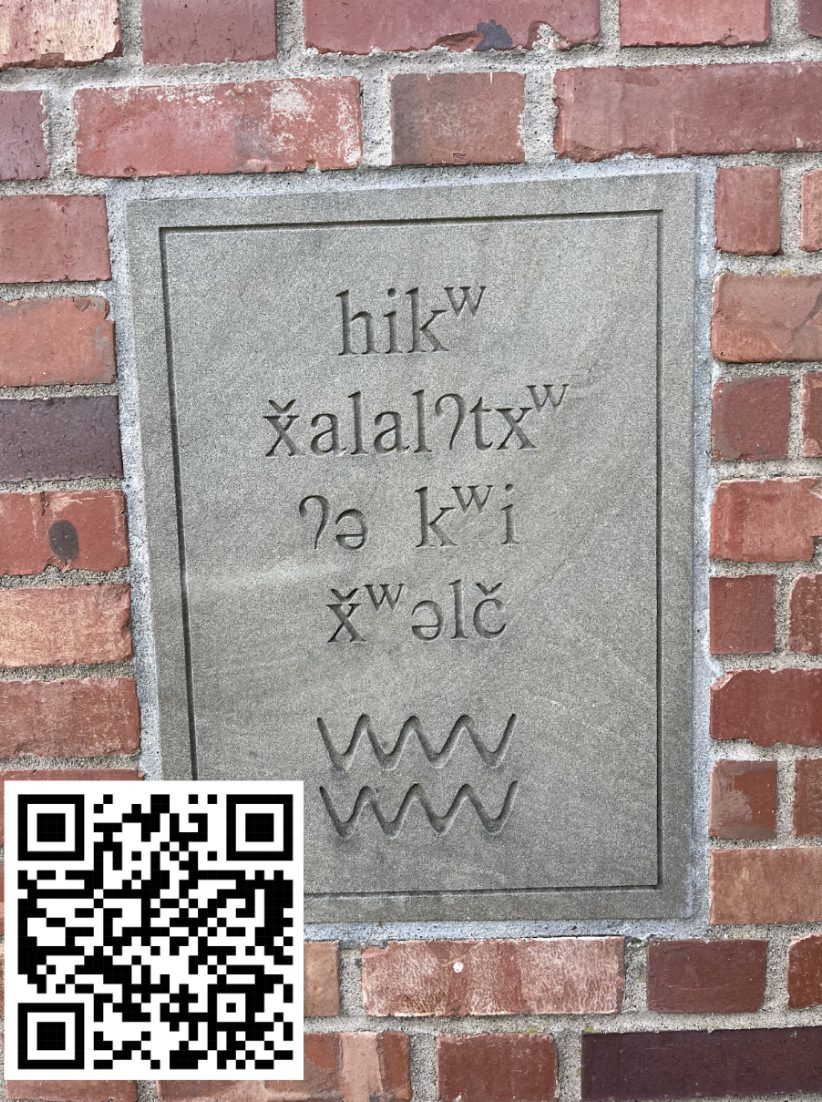
By Raka Custer
UNIVERSITY of PUGET SOUND, est. 1888 – look familiar? These are the words that announce themselves twice to anyone who drives up North 15th Street onto campus. The curving brick walls and their messages provide onlookers with a general sense of our institution: you are entering an English-language liberal arts college founded in the late 19th century (despite the University moving to its current site in 1924). Mostly undetected to those driving by, though, are two concrete plaques on the interior of the brick walls. The plaques come with no accompanying translation, date or clue to their origin, and as a result come across as a bit of a mystery. Each plaque contains a phrase written in Lushootseed (dxʷlušucid), the language spoken by 13 tribes in the Puget Sound region, including the Puyallup, Tulalip, Muckleshoot, and Snoqualmie. However, the phrases themselves might be more familiar than one expects; one needs to look no further than our alma mater. In English the plaques read as follows: “The University of Puget Sound” (left), and “Her guardian is the mountain” (right).
The design for the entry walls and the accompanying plaques was developed for the University in 2008 by Swift Company, the architectural firm behind several high-profile development and renewal projects like Seattle’s Ballard Commons and Climate Pledge Arena. The translations were created by members of the Tulalip Tribes of Washington, who were contracted by Swift Company.
The project was then put on hold until 2011, which was when it came to the attention of Douglas Sackman, Puget Sound professor of Pacific Northwest/Western American history. At the time, he was somewhat wary about the University’s request for the second Lushootseed translation, which was initially going to be “Our Guardian is Our Mountain.” This phrasing was ultimately changed before the project’s completion in 2011/2012 to match the lyrics of the alma mater, but for Sackman the question of appropriation still lingered; after the project was finalized, Sackman talked with some Lushootseed speakers who were not involved with the project to get their perspective on the translations.
“Would it seem appropriative to put the language up at all, right? And what I’ve been told, particularly around 2011 when this was coming out, was that the more and more places that the language could be seen in public, that was welcome,” Sackman said.
The Lushootseed alphabet was developed through a collaboration between Muckleshoot Lushootseed speakers and linguist Thom Hess in the 1960s to fit the language. Ensuring that their language is written in its proper alphabet holds high priority for Lushootseed speakers, and as such phonetically transcribed or anglicized spellings of the language are discouraged. The best way for lay-people to familiarize themselves with how the alphabet conveys Lushootseed’s distinguishing phonemes is through audio, something a concrete slab does not provide. However, in Swift Company’s 2008 conceptual development plan, they state that the plaques were created not to teach Lushootseed but instead to provoke curiosity. The plan reads:
“For the reader, the simple font illustrated is used to provide a clear articulation that can be recognized as text. The unique symbols of the translation reveal the mystery of the language. The scale and character of the lettering is intended to raise curiosity from the passer-by, and reveal a thoughtful expression to those who look deeper. It is intended to honor both First Nations and the members of the University community.”
This explanation raises a few questions: Is intentional ambiguity the right tool to use when representing a language (and by extension culture) that colonial forces have violently attempted to erase? How does one “look deeper” into the pieces’ meaning when their inconspicuous location and understated design give you no hint of where to start looking? Back in 2011 these questions may have been overshadowed by the higher priority of putting indigenous languages into the public eye. Sackman points to the more recent Seeding Lushootseed project, a collaboration between AFAM, the Environmental Policy & Decision Making Program and the Puyallup Tribal Language Program, as an improvement on the University’s first attempt at representing indigenous language and culture on campus.
“I think about what Renee Simms and Rachel DeMotts did with their class, and working with Lushootseed speakers on the Seeding Lushootseed [project] on campus, those are the signs of plants that we have up. I feel like that’s taking it a nicer step forward, because that was all done, as my understanding, in collaboration. We have the signs up now, and you can then hear how they’re translated with the QR codes,” Sackman said.
Chris Duenas, Media Developer at the Puyallup Tribal Language Program, has created two audio pronunciations for the plaques accessible via the QR codes above. If you would like to learn more about the Lushootseed Language, the website (www.puyalluptriballanguage.org) has a wealth of easily-accessible information and audio-visual media.
It’s a simple fact that Lushootseed and the indigenous peoples to which it belongs are here and thriving, not confined to the silence of concrete – there’s really nothing mysterious about that.
